The Impacts of Molybdenum Exploration on Cd and Zn Contents in Surface Water: Evidence from a Molybdenum Mine in the Xiaoqinling Mountains
Abstract
:1. Introduction
2. Materials and Methods
2.1. Study Area
2.2. Methods
2.2.1. Sample Collection
2.2.2. Sample Analysis
2.2.3. Single Element Pollution Index
2.2.4. Geoaccumulation Index
2.2.5. Potential Ecological Risk Index
2.2.6. USEPA Water Health Risk Assessment
3. Results
3.1. Results of the Samples in the Wenyu Stream
3.2. Excessive Cd Content in the Wenyu Stream
3.3. Excessive Zn Content in the Wenyu Stream
3.4. Evaluation of Cd Carcinogens
3.5. Health Risk Assessment of Zn through Skin and Drinking Water
3.6. Comprehensive Risk Assessment and Analysis
3.7. Degree of Accumulation of Cd and Zn in River Sediment
3.8. Excessive Cd and Zn in River Sediment
3.9. Potential Ecological Risk of Cd and Zn in Sediment
3.10. Comprehensive Index of Heavy Metal Pollution in Sediment
3.11. Content of Cd and Zn in Surrounding Rock
4. Discussion
4.1. Source of Acid Drainage from Mines Polluting the Wenyu Stream
4.2. Source of Surrounding Rock Polluted by the Wenyu Stream
4.3. Impact of Heavy Metal Release from Sediment on River Water
4.4. Sources of Heavy Metal Pollution from Atmospheric Dust Fall in the Wenyu Stream
4.5. Health Risks of Cd and Zn
5. Conclusions
Author Contributions
Funding
Data Availability Statement
Acknowledgments
Conflicts of Interest
References
- Xu, Y. Investigation and research on the mine geological environment: Present status and outlook. Geol. Bull. China 2008, 27, 1235–1244. [Google Scholar]
- Wang, X.; Yang, J.; Guo, H. Study on heavy metals in soil contaminated by coal waste rock pile. J. China Coal Soc. 2006, 31, 808–812. [Google Scholar]
- Wu, D.; Li, C.; Deng, Q.; Qin, F.; Jiang, X.; Wu, K.; Guo, W. Research on the Content of Heavy Metal in Crop Planting System in Typical Lead-zinc Soil and its Pollution Characteristics WUDietal. J. Anhui Agric. 2010, 38, 849–851. [Google Scholar]
- Zhou, F.Q.; Wang, X.; Zhao, X.; Li, X.; Huang, T.; Sun, Q. Heavy metal distribution and pollution evalution of rivers along mining area in Lujiang County, Anhui Province. Environ. Chem. 2020, 39, 2792–2803. [Google Scholar]
- Zuo, D.; Huang, J.; Wen, G.; Yue, M.; Liu, S. Morphological characteristics and ecological risk assessment of soil heacy metals in Lujiang alumite mine. Ecol. Sci. 2019, 38, 86–91. [Google Scholar]
- Zhang, J.; Wang, K.; Xu, Y.; Wu, Y.; Chen, H. Ecological hazard assessment of heavy metal pollution in sediments of Taiyu water system in Xiaoqinling. Geol. Bull. China 2018, 37, 2224–2232. [Google Scholar]
- Chen, Q.; Zhang, X.; Hu, M. Assessment of Aquatic Pollution of Heavy Metals in a Copper-iron Area. Environ. Sci. Technol. 2006, 29, 64–65. [Google Scholar]
- Huang, J.; Qin, M.; Ma, W.; Yu, J.; Peng, X.; Yang, L. Characteristics analysis and ecological risk assessment of heavy metals contamination in suspended solids in a river affected by acid mine drainage. Environ. Chem. 2016, 35, 2315–2326. [Google Scholar]
- Cai, Z. Migration, Transformation and Pollution Effects of Heavy Metals in Dabaoshan Mining Region. Master’s Thesis, Jinan University, Guangzhou, China, 2021. [Google Scholar]
- Ye, H.; Hong, X.; Zhao, J. Spatial migration and environmental effects of heavy metals in river sediments from in the Tongling mining area, Anhui province. China Environ. Sci. 2012, 32, 1853–1859. [Google Scholar]
- Fang, Y.; Sun, J.; Sun, M.; Shi, X.; He, Z.; Gong, Z.; Yao, M.; Sun, Y.; Xu, X.; Sui, H.; et al. Research progress on cadmium toxicity hazards and their prevention and control measures. J. Toxical 2022, 36, 517–520. [Google Scholar]
- Shi, Y.; Shi, G. Cadmium Pollution Characteristics and Health Risk of Soil Around Coal Mines in China. J. Huaibei Norm. Univ. 2022, 43, 56–63. [Google Scholar]
- Wang, Y.; Yang, J. Research and application of micro-electrolysis technology to industrial wasterwater treatment. Tech. Equip. Environ. Pollut. Control 2002, 4, 69–73. [Google Scholar]
- Shao, H. Bone pain in Japan. Geogr. Transl. 1984, 1, 64. [Google Scholar]
- Xu, D.; Zhang, J.; Ke, H.; Chen, H.; Liu, R. Analysis on Cd contamination in farmland soil in Tongguan goldmining area. Gold 2010, 31, 53–56. [Google Scholar]
- Wang, P.; Liu, H. Zinc imbalance and human health. Food Nutr. China 2007, 7, 50–51. [Google Scholar]
- Xiang, Z. The harm of excessive zinc supplementation to the human body. Mod. Med. Hyg. 2001, 9, 727. [Google Scholar]
- Ye, L.; Gao, W.; Yang, Y.; Liu, T.; Peng, S. Trace elements in sphalerite in Laochang Pb-Zn polymetallic deposit, Lancang, Yunnan Province. Acta Petrol. Sin. 2012, 28, 1362–1372. [Google Scholar]
- Zhang, Y.; Wang, B.; Duan, L.; Fu, X.; Qi, S. Practice of Ecological Restoration of Water Environment in Middle of Northern Foothills of Qinling Mountains. Environ. Sci. Manag. 2023, 48, 150–154. [Google Scholar]
- Ren, T.; Zheng, J. Geological characteristics of the deep orebody in the north open pit of Jinduicheng molubdenum deposit, Huanxian County, Shannxi Province. World Nonferrous Met. 2019, 19, 252–254. [Google Scholar]
- Jiao, J.; Yuan, H.; He, K.; Sun, T.; Xu, G.; Liu, R. Zircon U-Pb and Molybdenite Re-Os Dating for the Balipo Porphyry Mo Deposit in East Qinling, China, and Its Geological Implicatin. Acta Geol. Sin. 2009, 83, 1159–1166. [Google Scholar]
- DD2005-03; Technical Code for China Geological Survey-Technical Requirements for Analysis of Ecological Geochemical Evaluation Samples (DD2005-03). China Geological Survey: Beijing, China, 2005.
- GB/T 14353. 4-2010; Methods for Chemical Analysis of Copper Ores, Lead Ores and Zinc Ores. China Environmental Science Press Co., Ltd.: Beijing, China, 2010.
- Hua, L.; Hua, L.; Gao, J.; Zhang, Z.; Yin, X.; Zhu, F.; Wang, X. Heavy Metal Pollution of Sediments of Lakes in China. Soils 2006, 38, 366–373. [Google Scholar]
- Li, Z.; Hou, J.; Wang, J. Potential ecological risk assessment model for heavy metal contamination of agricultural soils in mining areas. Adv. Earth Sci. 2008, 23, 509–516. [Google Scholar]
- Qin, H.; Huang, L.; Gao, B. Content, distribution characteristics and ecological risk assessment of Cu and Zn in the water body of Lhasa River. Environ. Pollut. Prev. 2023, 45, 363–369. [Google Scholar]
- Tian, X.; Ding, W.; Zhang, H.; Xu, D.; Guo, X. Water environment health risk assessment in part of Gansu Province from 2011 to 2015. Environ. Chem. 2019, 38, 142–151. [Google Scholar]
- Guo, C.; Fang, H.; Wang, J.; Liu, J.; Zhang, F.; Liu, X. Characteristics and potential ecological risk evaluation of heavy metal pollutant in sediment of black-odorous water. Yangtze River 2022, 53, 20–26. [Google Scholar]
- Sun, S.; Hu, G.; Wang, Y.; Li, C. Water environmental health risk assessment of Xiangjiang River. J. Saf. Environ. 2006, 6, 12–15. [Google Scholar]
- Pan, A.; He, Y.; Ma, R. Zoning of environmental geochemistry in shaanxi province. Adv. Earth Sci. 2004, 19, 439–443. [Google Scholar]
- Xue, D.; Xiao, L.; Wu, Q.; Li, D.; Wang, K.; Li, H.; Wang, R. Study on the background values of ten elements in the main agricultural soils of Shaanxi Province. J. Northwest AF Univ. 1986, 3, 30–53. [Google Scholar]
- Dwivedi, A.; Vankar, P.S. Source identification study of heavy metal contamination in the industrial hub of Unnao, India. Environ. Monit. Assess. 2014, 186, 3531–3539. [Google Scholar] [CrossRef]
- Zhang, Z.; Lu, Y.; Li, H.; Tu, Y.; Liu, B.; Yang, Z. Assessment of heavy metal contamination, distribution and source identification in the sediments from the Zijiang River, China. Sci. Total Environ. 2018, 645, 235–243. [Google Scholar] [CrossRef]
- Wang, X.; Gao, Y.; Jiang, X.; Zhang, Q.; Liu, W. Analysis on the characteristics of water pollution caused by underground mining and research progress of treatment technology. Adv. Civ. Eng. 2021, 2021, 9984147. [Google Scholar] [CrossRef]
- Zhao, H.; Yang, Z.; Zhang, H.; Meng, J.; Jin, Q.; Ming, S. Emergency Monitoring of a Tailings Pond Leakage Accident Based on the GEE Platform. Sustainability 2022, 14, 8558. [Google Scholar] [CrossRef]
- Yang, K.; Wang, Q.; Jin, Y. Brief analysis of the effectiveness of water inrush treatment in an acid mine in eastern Sichuan. China Met. Bull. 2022, 3, 237–239. [Google Scholar]
- Zhang, R.; Wu, P.; Yang, Y. Study on New Methods for Treating Acid Mine Drainage with Passive Treatment Technology. Earth Environ. 2010, 38, 250–254. [Google Scholar]
- Lin, Q.; Liao, B.; Yang, R. Recent advances on the comprehensive treatments of wasted mne soils and waters. Tech. Equip. Environ. Pollut. Control 2000, 6, 7–10. [Google Scholar]
- Wang, S.; Wu, W.; Liu, F.; Liao, R.; Hu, Y. Accumulation of heavy metals in soil-crop systems: A review for wheat and corn. Environ. Sci. Pollut. Res. 2017, 24, 15209–15225. [Google Scholar] [CrossRef] [PubMed]
- Wei, J.; Wu, D.; Peng, J. Release and kintics of heavy metals from the contaminated sediments. Ecol. Environ. 2003, 12, 127–130. [Google Scholar]
- Gong, K.Y. Study on the Release Law and Pollution Features of Heavy Metals in the Sediments of Harbin Section of SongHua River. Master’s Thesis, Harbin Institute of Technology, Harbin, China, 2014. [Google Scholar]
- Shi, M.; Wang, Z.; Wang, J. Assessment for ecological risk of soil heavy metals with Hakanson index method: A review. J. Soil Sci. 2019, 50, 1002–1008. [Google Scholar]
- Xu, L.; Deng, S.; Chen, J. River sediment pollution and its control and restoration. Ecol. Environ. Sci. 2014, 23, 1708–1715. [Google Scholar]
- Entwistle, J.A.; Hursthouse, A.S.; Reis, P.A.M.; Stewart, A.G. Metalliferous mine dust: Human health impacts and the potential determinants of disease in mining communities. Curr. Pollut. Rep. 2019, 5, 67–83. [Google Scholar] [CrossRef]
- Ding, H. Study of Heavy Metal Pollution od the Sediment in BeiYunHe River in Beijing. Master’s Thesis, Capital Normal University, Beijing, China, 2009. [Google Scholar]
- Ling, S.; Yu, C.; Lu, S. Flux characteristics of heavy inputted by atmospheric dry and wet deposition to a city system—A case study of Shenyang city. J. Anhui Agric. 2013, 41, 10764–10765+10792. [Google Scholar]
- Zhang, S.; Bi, M.; Jiang, H.; Gao, W. Inhibition evaluation of gas inhibitors in micron-sized aluminum dust explosion. J. Hazard. Mater. 2020, 393, 122524. [Google Scholar] [CrossRef] [PubMed]
- Li, R.; Yu, M.; Zhu, W.; Zhang, R. Research of Comprehensive Control Measures for Tailings Dust. Met. Mine 2011, 1, 142–146. [Google Scholar]
- Hayat, M.; Nauman, M.; Nazir, N. Environmental hazards of cadmium: Past, present, and future. In Cadmium Toxicity and Tolerance in Plants; Academic Press: Cambridge, MA, USA, 2019; pp. 163–183. [Google Scholar]
- Huang, B. Biological toxicity of cadmium and its prevention and control strategies. Bull. Biol. 2005, 11, 26–28. [Google Scholar]
- Elshama, S.S.; Abdallah, M.E.; Abdel-Karim, R.I. Zinc oxide nanoparticles: Therapeutic benefits and toxicological hazards. Open Nanomed. J. 2018, 5, 16–22. [Google Scholar] [CrossRef]
- Zhou, B.; Zeng, Y.; Benjamin, F. Spatial and temporal health risk assessment of water environment in urban area. Geogr. Geo-Inf. Sci. 2009, 25, 94–98. [Google Scholar]
- Chen, Q.; Yao, Y.; Li, X. Comparison of heavy metal removals from aqueous solutions by chemical precipitation and characteristics of precipitates. J. Water Process Eng. 2018, 26, 289–300. [Google Scholar] [CrossRef]
- Mei, Y.; Tang, C. Recent developments and future perspectives of reverse electrodialysis technology: A review. Desalination 2018, 425, 156–174. [Google Scholar] [CrossRef]
- Zheng, Y.; Peng, Y.; Le, H. Separation and recovery of Zn, Fe and Mn in acid mine drainage. J. Cent. South Univ. (Sci. Technol.) 2011, 42, 1858–1864. [Google Scholar]
- Zakari, A.; Khan, I.; Tan, D.; Alvarado, R.; Dagar, V. Energy efficiency and sustainable development goals (SDGs). Energy 2022, 239, 122365. [Google Scholar] [CrossRef]
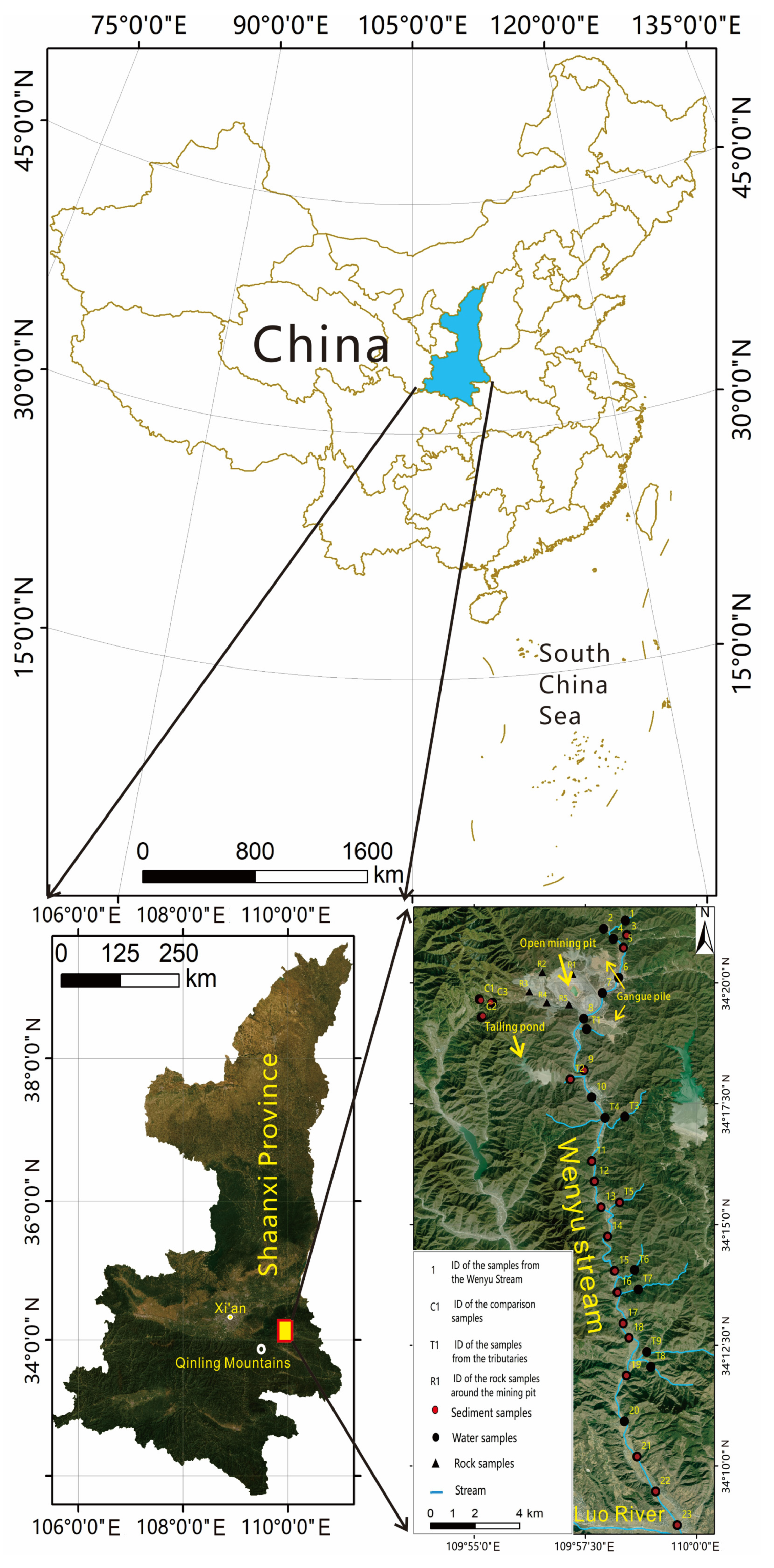
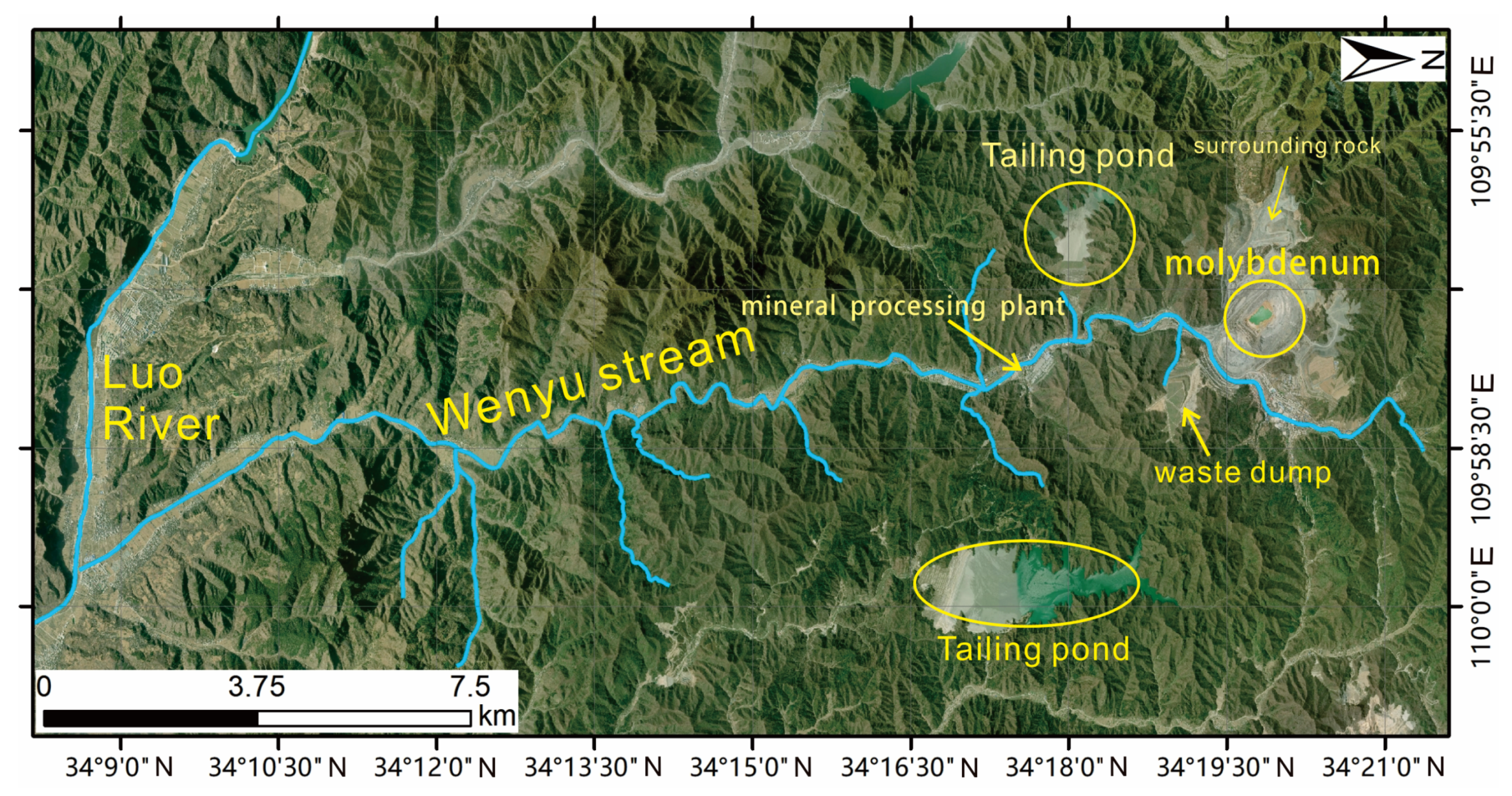
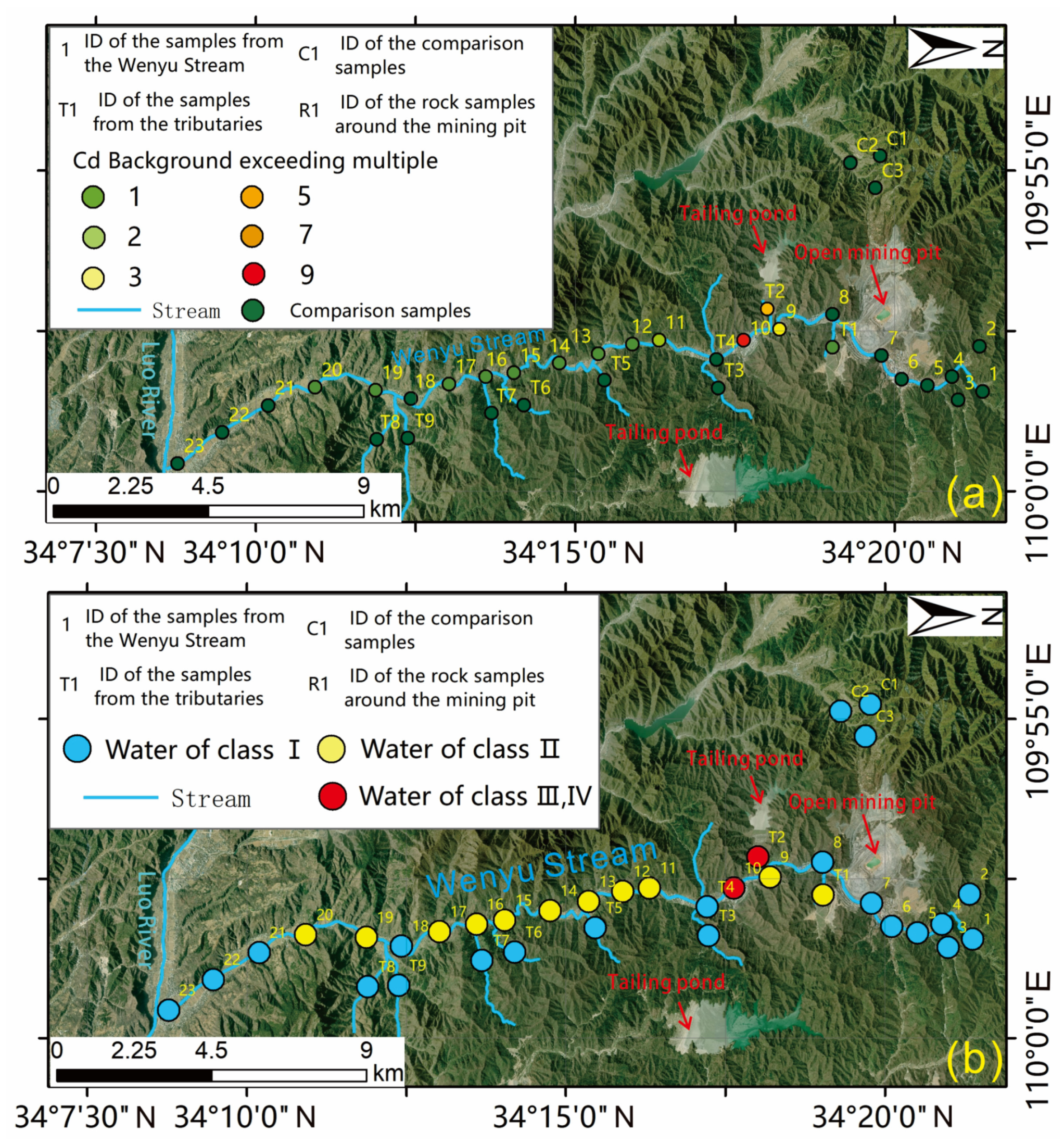

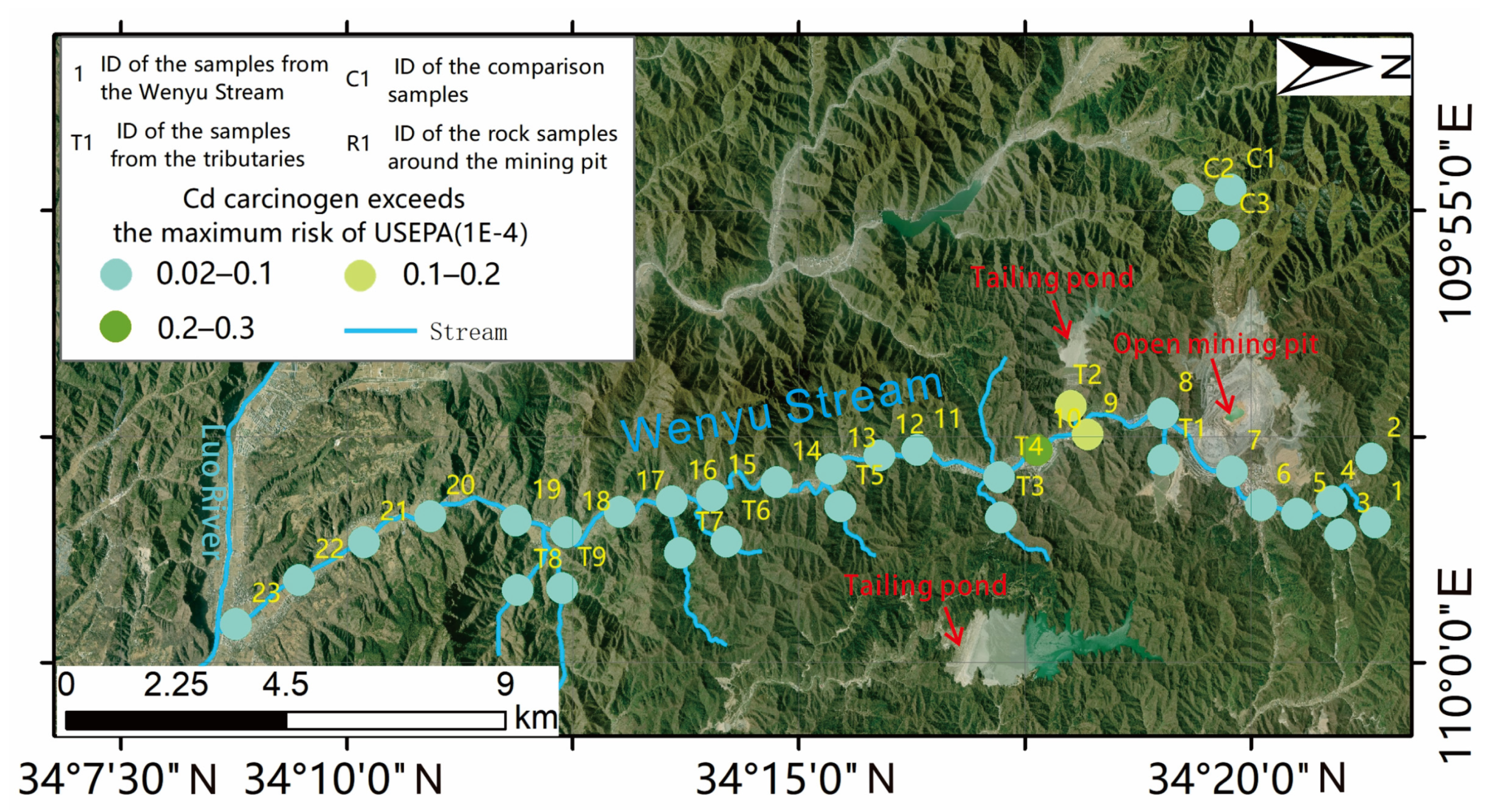
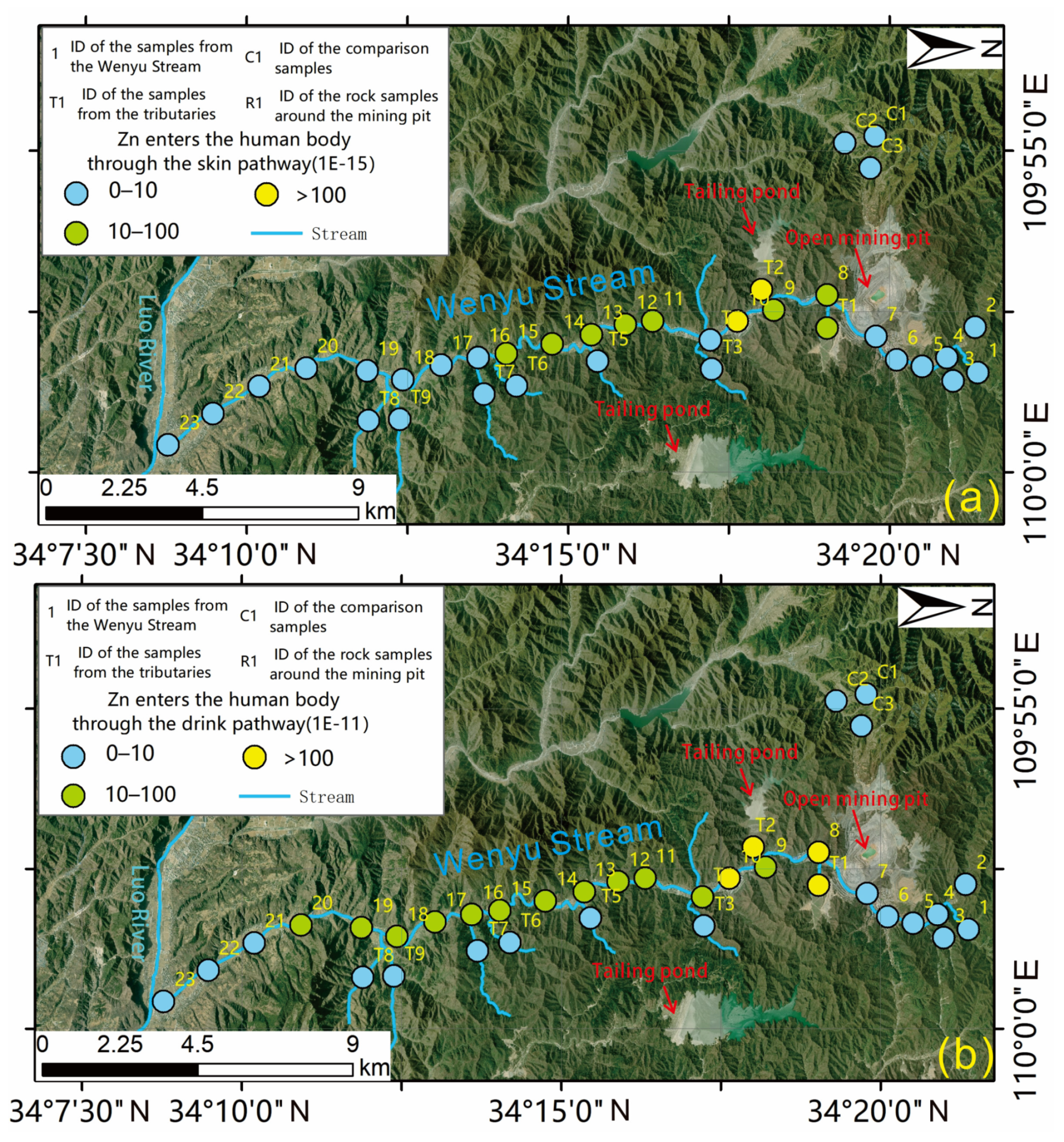
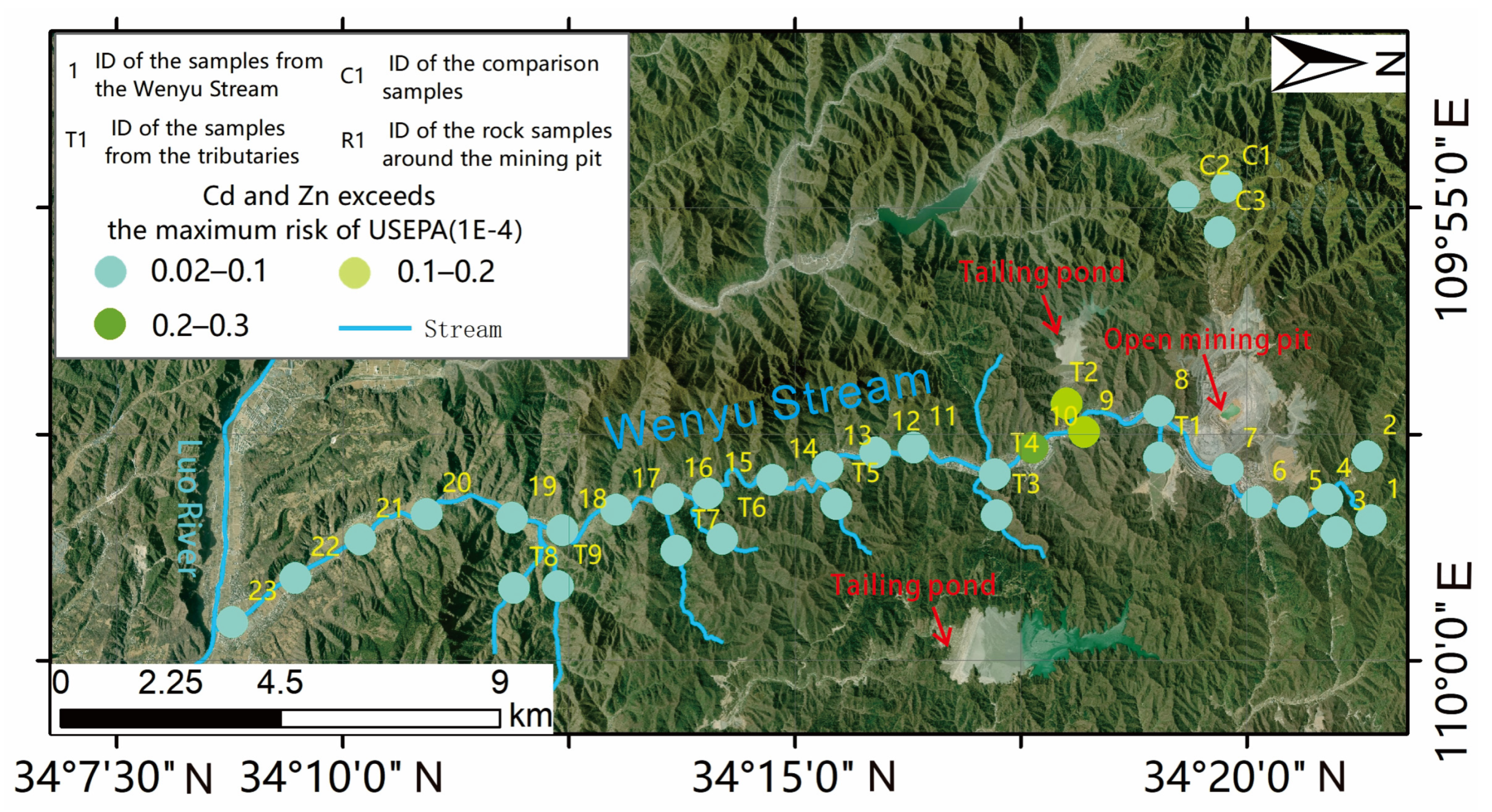
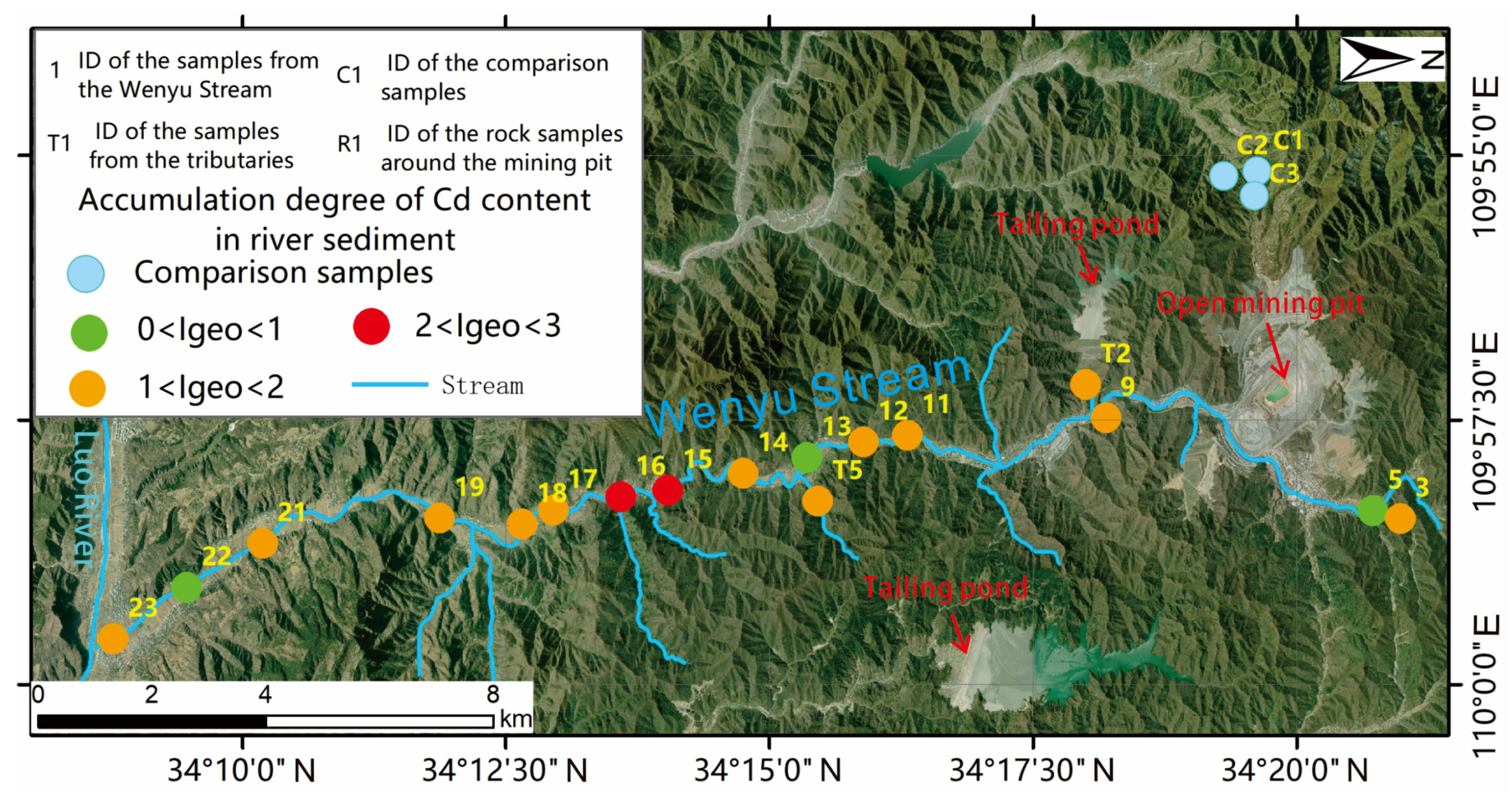
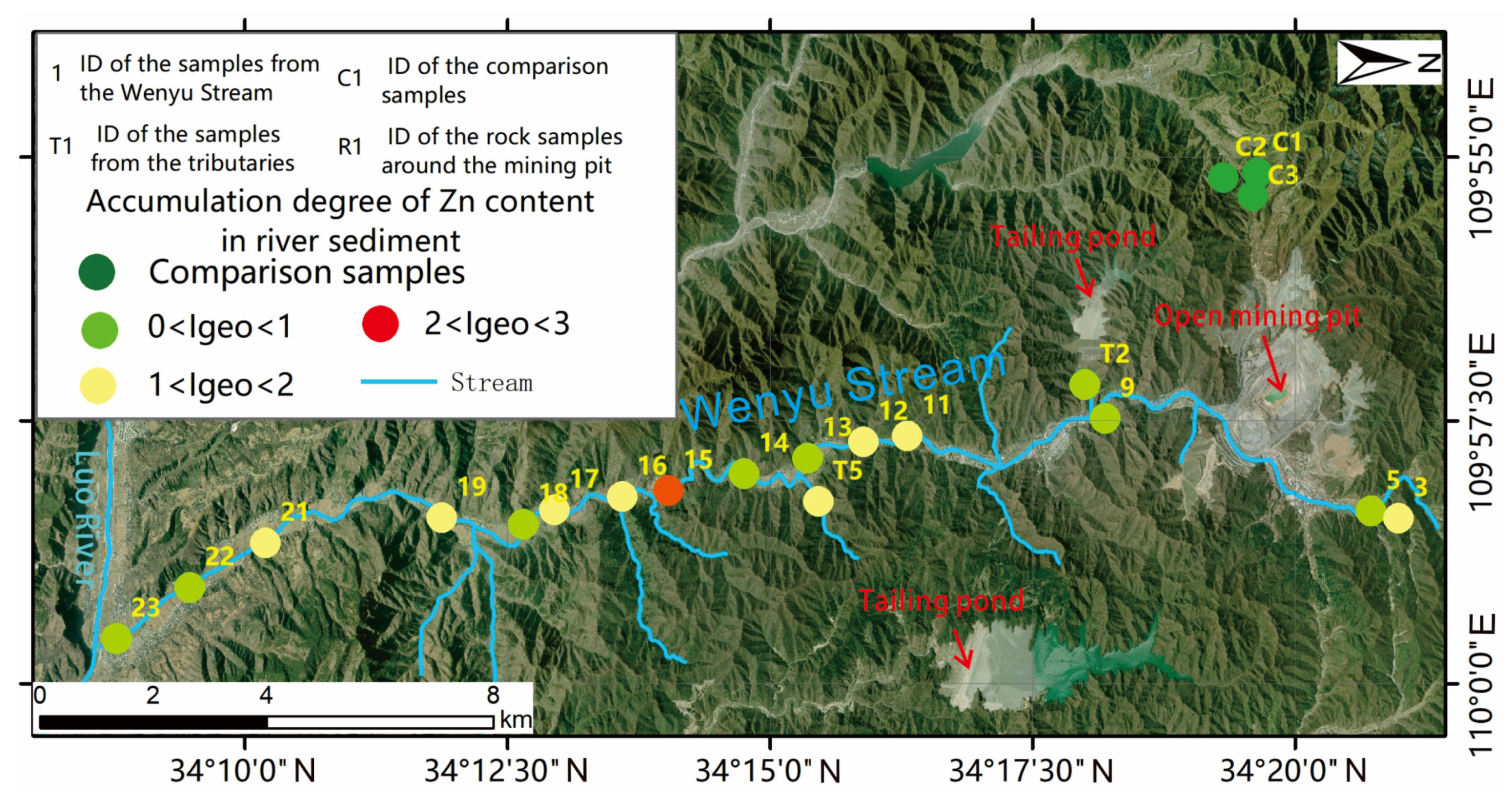
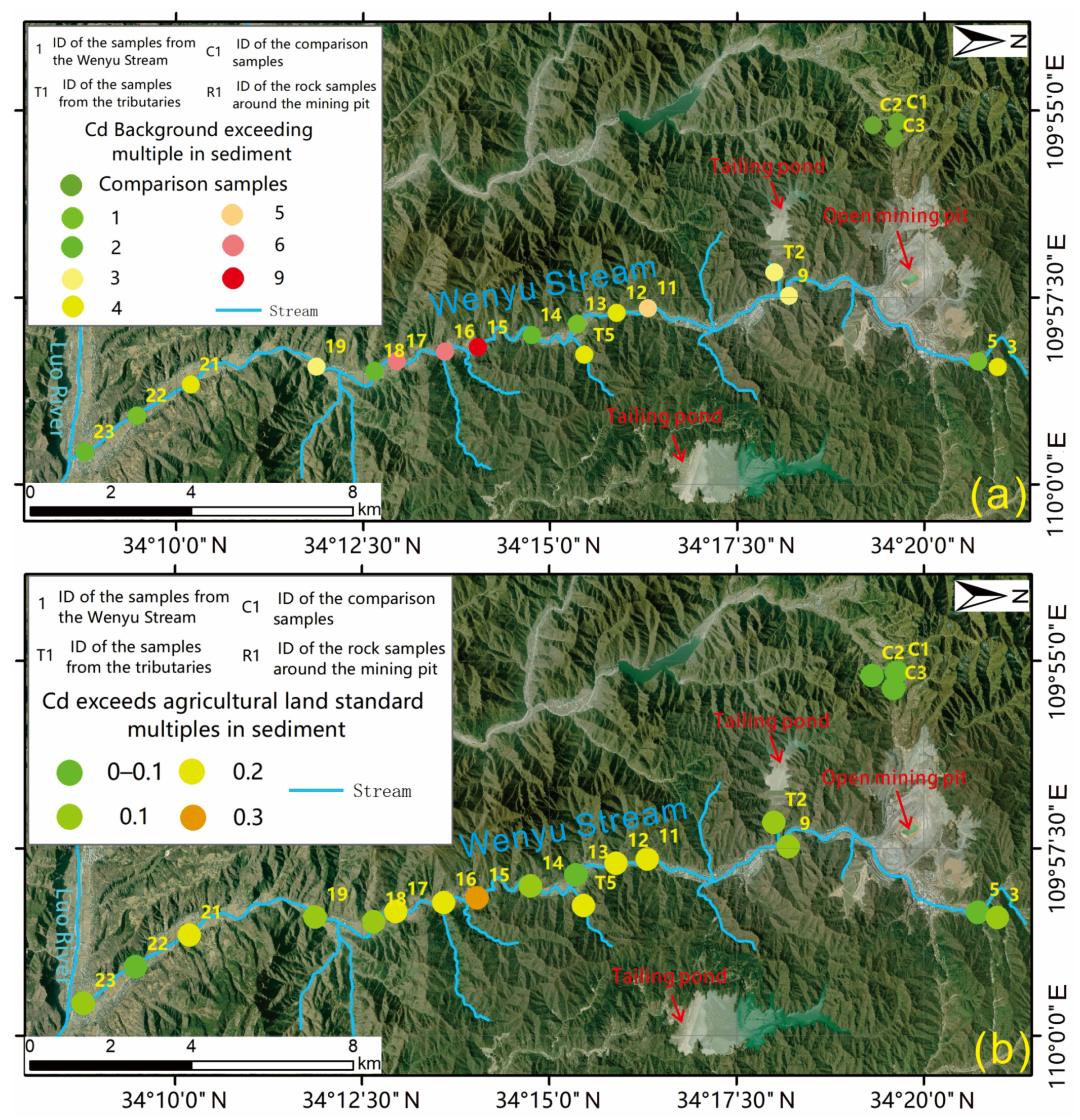
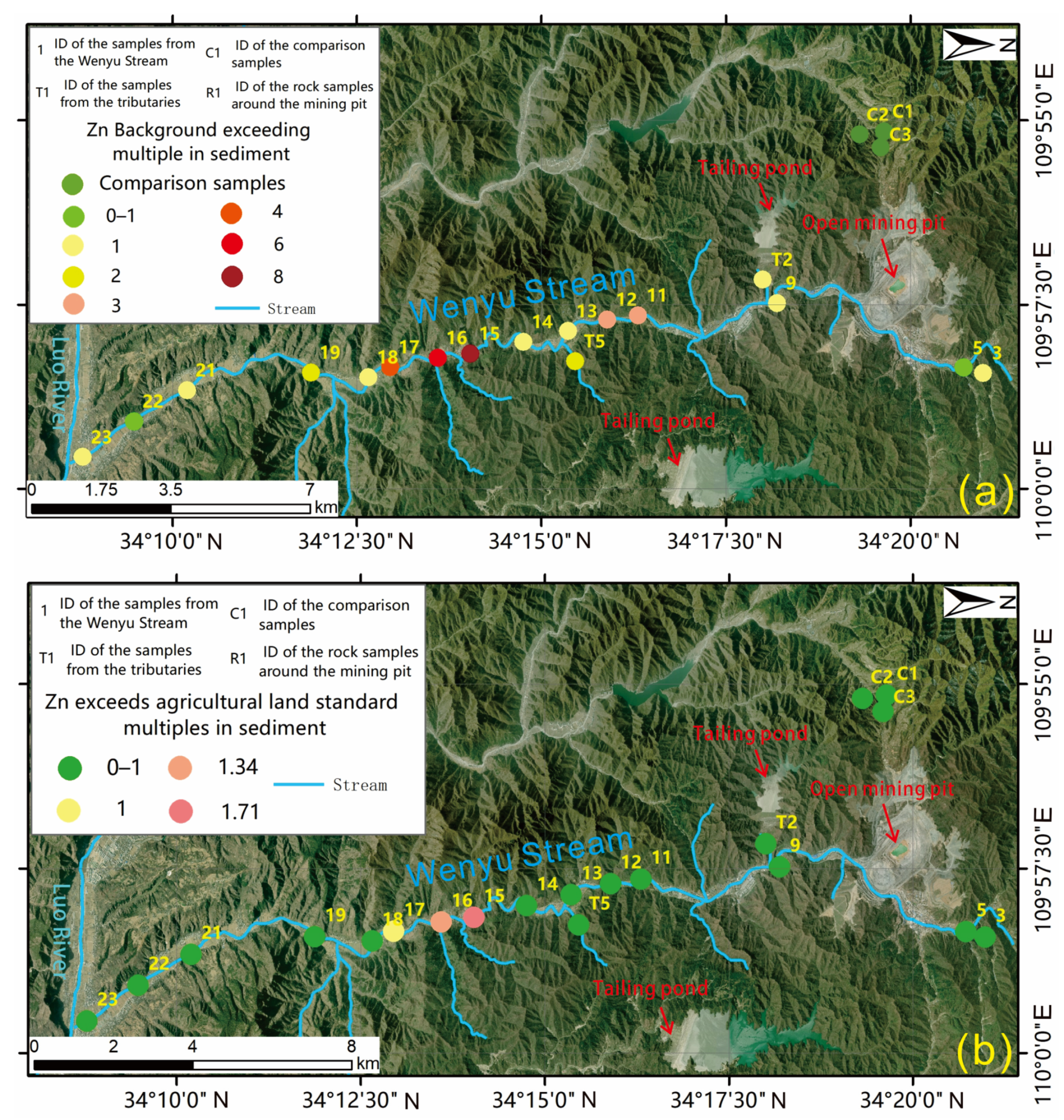
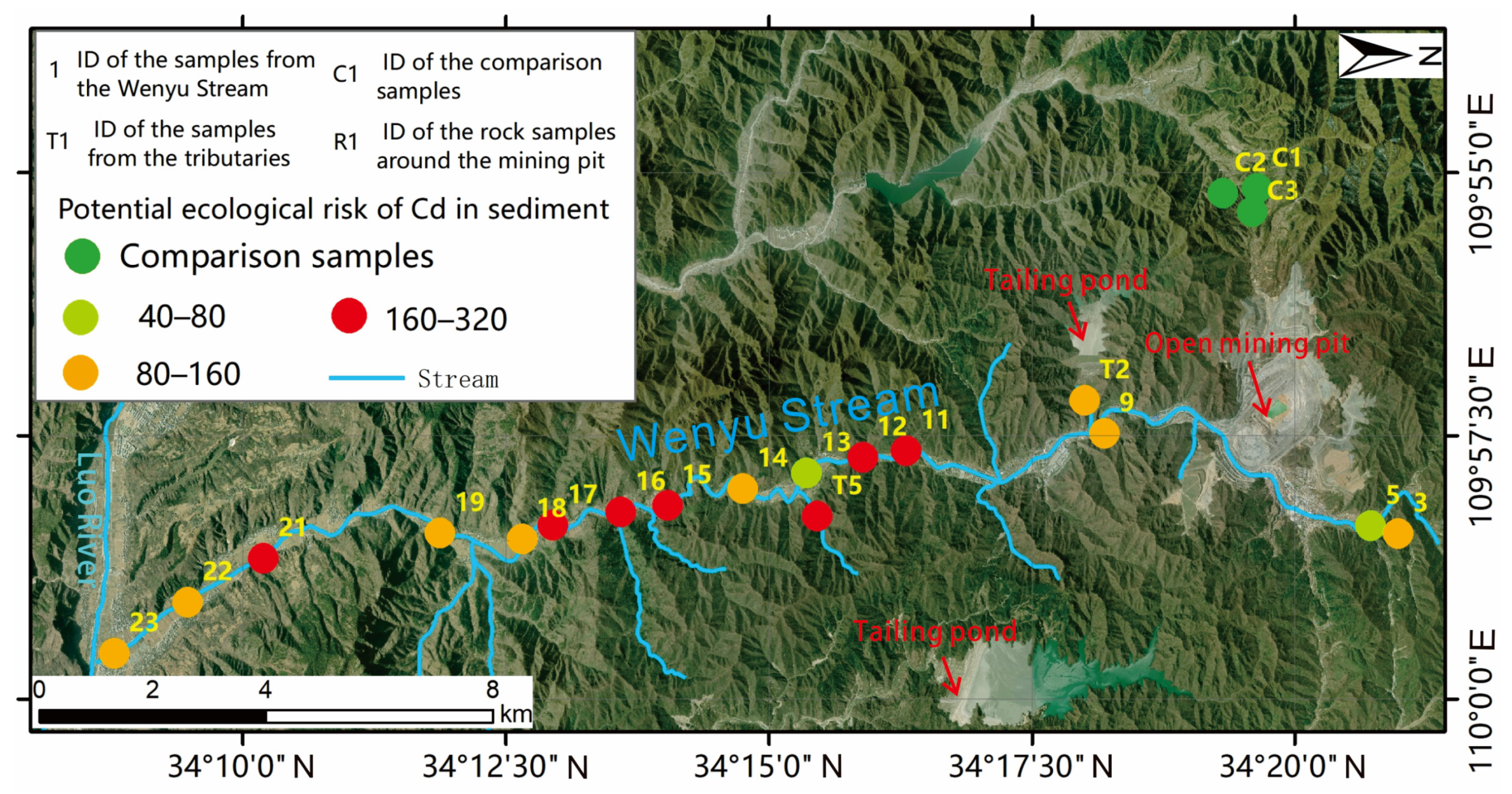

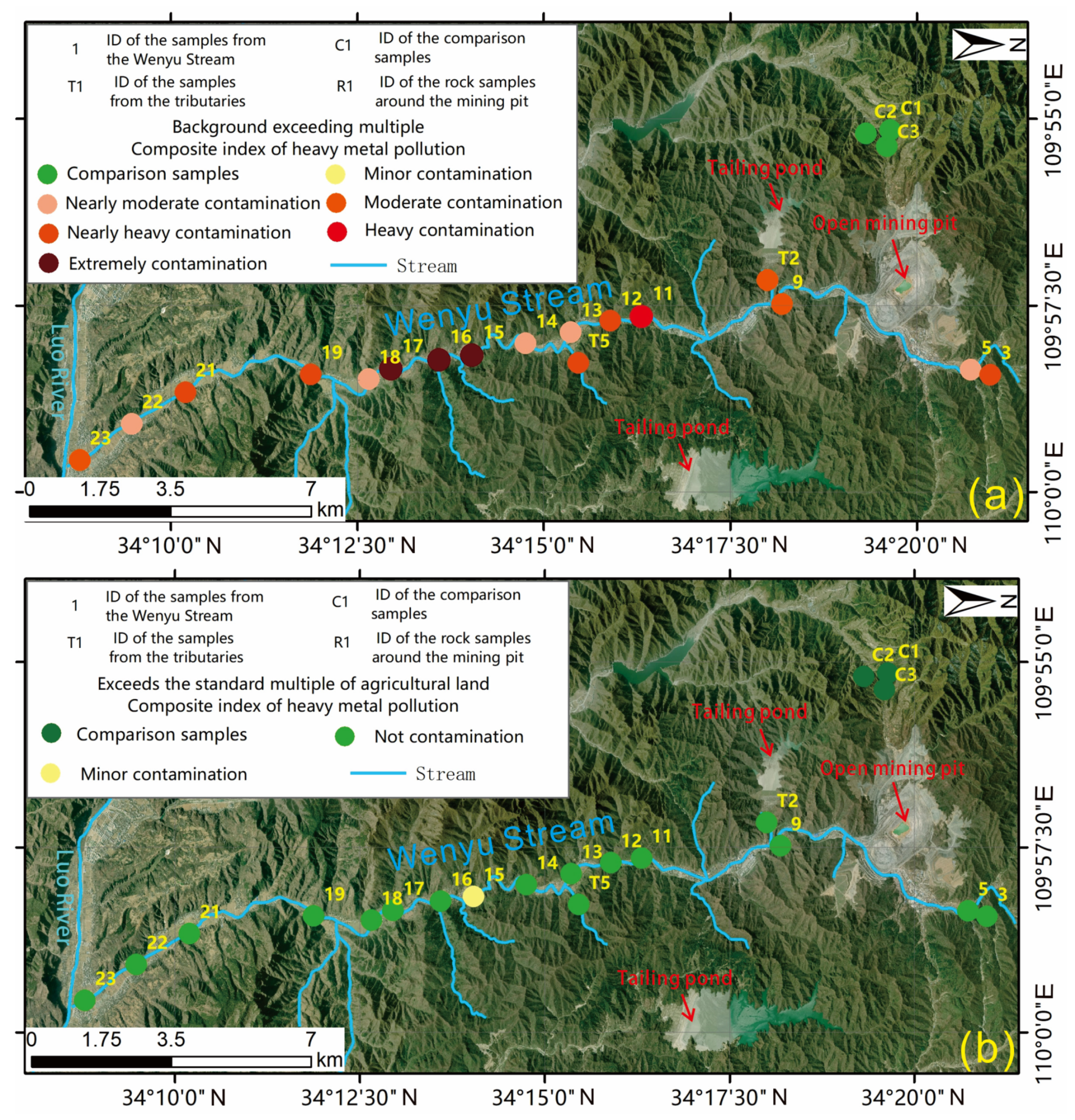

| Pollution Level | Uncontaminated | Slightly Polluted | Moderately Polluted | Heavy Polluted | Extreme Polluted |
|---|---|---|---|---|---|
| Single-element pollution index () | ≤ 0 | ≤ 1 | ≤ 4 | ≤ 10 |
| Pollution Level | Pollution-Free | No Pollution– Moderate Pollution | Moderately Polluted | Moderate to Severe Pollution | Severe Pollution | Severe Pollution–Extreme Pollution | Extreme Pollution |
|---|---|---|---|---|---|---|---|
| Index range | Igeo ≤ 0 | 0 < Igeo ≤ 1 | 1 < Igeo ≤ 2 | 2 < Igeo ≤ 3 | 3 < Igeo ≤ 4 | 4 < Igeo ≤ 5 | 5 < Igeo |
| Level | 0 | 1 | 2 | 3 | 4 | 5 | 6 |
| Ecological Risk Degree | Slight | Medium | Strong | Very Strong | Extremely Strong |
|---|---|---|---|---|---|
| Index range | <40 | < 80 | < 160 | < 320 |
| Symbol | Meaning | Value | Unit |
|---|---|---|---|
| k | The skin adsorption coefficient | 0.001 | cm/h |
| The mass concentration of non-carcinogen element I | - | mg/L | |
| The hysteresis time in water | 1 | h | |
| TE | The duration of human wading behavior | 0.4 | h |
| A | The surface area of human body | 16,600 | cm2 |
| FE | The frequency of wading behavior | 0.3 | time/d |
| EF | Exposure frequency | 365 | d/a |
| ED | Exposure delay | 35 | a |
| W | Average body weight | 70 | kg |
| AT | The average exposure time | 12,775 | d |
| f | Intestinal absorption rate | 1 | - |
| The reference dose of non-carcinogenic pollutant I through drinking water | 0.14 | mg/(kg·d) | |
| WDU | Daily drinking water consumption per person | 2.2 | L/d |
| Degree | Uncontaminated | Slightly Polluted | Nearly Moderate Pollution | Moderate Pollution | Nearly Heavy Pollution | Heavy Pollution | Extreme Pollution |
|---|---|---|---|---|---|---|---|
| P | ≤1 | 1~2 | 2~3 | 3~4 | 4~5 | 5~6 | >6 |
| Pollution level | 0 | 1 | 2 | 3 | 4 | 5 | 6 |
| Number (in Water) | Cd (μg/L) | Zn (μg/L) | pH Value |
|---|---|---|---|
| 1 | 1.000 | 8.000 | 7.750 |
| 2 | 1.000 | 12.000 | 7.320 |
| 3 | 1.000 | 8.000 | 8.150 |
| 4 | 1.000 | 5.000 | 7.200 |
| 5 | 1.000 | 15.000 | 7.440 |
| 6 | 1.000 | 30.000 | 7.320 |
| 7 | 1.000 | 7.000 | 7.030 |
| 8 | 1.000 | 710.000 | 6.760 |
| 9 | 4.000 | 290.000 | 6.780 |
| 10 | 10.000 | 1360.000 | 5.210 |
| 11 | 3.000 | 170.000 | 7.430 |
| 12 | 2.000 | 110.000 | 7.440 |
| 13 | 2.000 | 110.000 | 7.470 |
| 14 | 2.000 | 110.000 | 7.740 |
| 15 | 2.000 | 95.000 | 7.820 |
| 16 | 2.000 | 75.000 | 7.550 |
| 17 | 2.000 | 64.000 | 7.720 |
| 18 | 1.000 | 42.000 | 7.800 |
| 19 | 2.000 | 47.000 | 8.280 |
| 20 | 2.000 | 37.000 | 7.780 |
| 21 | 1.000 | 9.000 | 7.420 |
| 22 | 1.000 | 16.000 | 7.830 |
| 23 | 1.000 | 19.000 | 6.960 |
| C1 | 1.000 | 31.000 | 7.260 |
| C2 | 1.000 | 12.000 | 7.560 |
| C3 | 1.000 | 1.000 | 7.620 |
| T1 | 2.000 | 690.000 | 6.730 |
| T2 | 6.000 | 1210.000 | 6.000 |
| T3 | 1.000 | 21.000 | 6.930 |
| T4 | 8.000 | 1210.000 | 6.130 |
| T5 | 1.000 | 23.000 | 7.890 |
| T6 | 1.000 | 18.000 | 7.330 |
| T7 | 1.000 | 13.000 | 7.610 |
| T8 | 1.000 | 2.000 | 7.770 |
| T9 | 1.000 | 5.500 | 8.270 |
| Number (in Sediment) | Cd (mg/kg) | Zn (mg/kg) |
|---|---|---|
| 3 | 3.780 | 532.000 |
| 5 | 1.760 | 333.000 |
| 9 | 3.490 | 527.000 |
| 11 | 5.100 | 886.000 |
| 12 | 4.120 | 796.000 |
| 13 | 1.950 | 466.000 |
| 14 | 2.220 | 518.000 |
| 15 | 7.660 | 1710.000 |
| 16 | 5.890 | 1340.000 |
| 17 | 5.200 | 1000.000 |
| 18 | 2.320 | 449.000 |
| 19 | 3.410 | 677.000 |
| 21 | 4.060 | 556.000 |
| 22 | 2.000 | 363.000 |
| 23 | 2.940 | 464.000 |
| C1 | 0.900 | 200.000 |
| C2 | 0.600 | 141.000 |
| C3 | 0.720 | 221.000 |
| T2 | 3.170 | 420.000 |
| T5 | 4.040 | 704.000 |
| Mode | Median | Range | Range/Mode | Range/Average | Standard Deviation | Coefficient of Variation |
|---|---|---|---|---|---|---|
| 0.001 | 0.001 | 0.009 | 9 | 4.299 | 0.002 | 99.440% |
Disclaimer/Publisher’s Note: The statements, opinions and data contained in all publications are solely those of the individual author(s) and contributor(s) and not of MDPI and/or the editor(s). MDPI and/or the editor(s) disclaim responsibility for any injury to people or property resulting from any ideas, methods, instructions or products referred to in the content. |
© 2023 by the authors. Licensee MDPI, Basel, Switzerland. This article is an open access article distributed under the terms and conditions of the Creative Commons Attribution (CC BY) license (https://creativecommons.org/licenses/by/4.0/).
Share and Cite
Yang, M.; Fu, W.; Chen, H.; Zhang, X.; Zhao, A.; Xu, Y. The Impacts of Molybdenum Exploration on Cd and Zn Contents in Surface Water: Evidence from a Molybdenum Mine in the Xiaoqinling Mountains. Minerals 2023, 13, 1207. https://doi.org/10.3390/min13091207
Yang M, Fu W, Chen H, Zhang X, Zhao A, Xu Y. The Impacts of Molybdenum Exploration on Cd and Zn Contents in Surface Water: Evidence from a Molybdenum Mine in the Xiaoqinling Mountains. Minerals. 2023; 13(9):1207. https://doi.org/10.3390/min13091207
Chicago/Turabian StyleYang, Min, Weishun Fu, Huaqing Chen, Xin Zhang, Aning Zhao, and Youning Xu. 2023. "The Impacts of Molybdenum Exploration on Cd and Zn Contents in Surface Water: Evidence from a Molybdenum Mine in the Xiaoqinling Mountains" Minerals 13, no. 9: 1207. https://doi.org/10.3390/min13091207
APA StyleYang, M., Fu, W., Chen, H., Zhang, X., Zhao, A., & Xu, Y. (2023). The Impacts of Molybdenum Exploration on Cd and Zn Contents in Surface Water: Evidence from a Molybdenum Mine in the Xiaoqinling Mountains. Minerals, 13(9), 1207. https://doi.org/10.3390/min13091207








